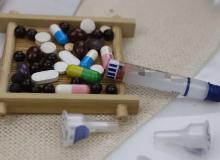Xiao Wang (pseudonym) was influenced by me and started to pay attention to blood sugar. Therefore, he bought a set of sugar nurse blood glucose meters from JD.com to monitor his blood sugar. Once he measured blood sugar 9.1mmol 2 hours after lunch. /L, which was about 2mmol/L higher than usual. He immediately became worried and went to Ask the Doctor on the Sugar Nurse APP to consult the doctor. Did he have diabetes? Then there are many people with diabetes who have similar problems.
So today Xiaonuo is here to analyze this question for you! Can fingertip blood diagnose diabetes? Before answering this question, you must first understand the difference between fingertip blood glucose and venous blood glucose, and you will naturally have the answer! Fingertip blood glucose blood venous blood VS
1. Fingertips are the best place for microcirculation in the whole body. Fingertip blood can make a preliminary assessment of a person's physical condition. For diabetics who insist on using a rapid blood glucose monitor to self-test their blood sugar, the purpose is to observe hypoglycemic treatment. The effect and whether there is hypoglycemia. Venous blood is the blood that flows back from the body to the heart. Drawing blood there can make a more systematic assessment of the body.
2. The rapid blood glucose meter measures the blood sugar value of peripheral blood. When fasting, theoretically speaking, peripheral blood sugar is lower than venous blood sugar. After eating, the glucose absorbed by the human body first reaches the arteries, then consumes part of the glucose through peripheral capillary metabolism, and then returns to the veins. Therefore, arterial blood glucose levels are higher than venous blood glucose levels after eating. And because the glucose content in capillaries and arteries is close, and it is difficult to test immediately after venous blood drawing, and the longer the specimen is left, the blood sugar will decrease due to glycolysis.
Therefore, peripheral blood sugar is correspondingly higher than venous blood sugar after eating. According to the recommendations of the Diabetes Branch of the Chinese Medical Association, venous blood should be collected at present, plasma blood glucose should be measured using the glucose oxidase method, and diagnosis or exclusion should be made based on the value. It is not recommended to use fingertip blood sugar values to diagnose diabetes. However, finger blood sugar can be used as one of the important measures to understand the effect of treatment during diabetes treatment.
Therefore, when diagnosing diabetes or conducting diabetes screening, venous blood must be drawn for testing, and the fingerstick blood monitoring value should be used as a reference value. Glycated hemoglobin is used to measure average blood sugar levels over the two to three months before a blood draw. The American Diabetes Association recommended in 2010 that a glycosylated hemoglobin level of ≥6.5% can be diagnosed as type 2 diabetes. If it is between 5.7% and 6.4%, it can be diagnosed as prediabetes or prediabetes high-risk state. Since the measurement method of glycated hemoglobin is not unified in my country, glycated hemoglobin has not yet been used as a standard for diagnosis of diabetes. Therefore, the diagnosis of diabetes still requires testing of venous plasma blood glucose.
So, how to diagnose diabetes clinically? The first situation: If there are some typical symptoms of diabetes, namely "three more and one less" (polydip, polyuria, weight loss, skin itching, vision loss caused by high blood sugar) In addition to symptoms of acute metabolic disorders such as blurring, etc.), plus plasma glucose ≥ 11.1mmol/L or fasting plasma glucose ≥ 7.0mmol/L at any time point (regardless of when to eat, exercise, etc.), or 75 g oral glucose tolerance Diabetes can be diagnosed if plasma glucose ≥11.1mmol/L within 2 hours of the test.
Note: ※ The diagnostic criteria for diabetes in children are the same as those in adults. ※ Fasting means no calorie intake for at least 8 hours. ※ Any time refers to any time within a day, regardless of the last meal time and food intake. ※ Glucose tolerance test (OGGTT) refers to taking 75 grams of anhydrous glucose as a loading dose, dissolved in water, and taken orally. ※ It is recommended that anyone whose fasting or random blood sugar is at the upper limit of normal should undergo a glucose tolerance test (OGGTT).
※ Glycated hemoglobin (HbA1c) cannot be used to diagnose diabetes, nor can glucose tolerance test (OGGTT) be used to monitor blood sugar control. The second situation: If there are no typical symptoms of "three more and one less", the diagnosis cannot be made even if the results meet the diagnostic criteria for diabetes. It is necessary to repeat the test once, and the diagnosis of diabetes can only be confirmed if the diagnostic criteria are still met. After diagnosing diabetes, type diagnosis should be made based on its clinical and pathophysiological characteristics.

